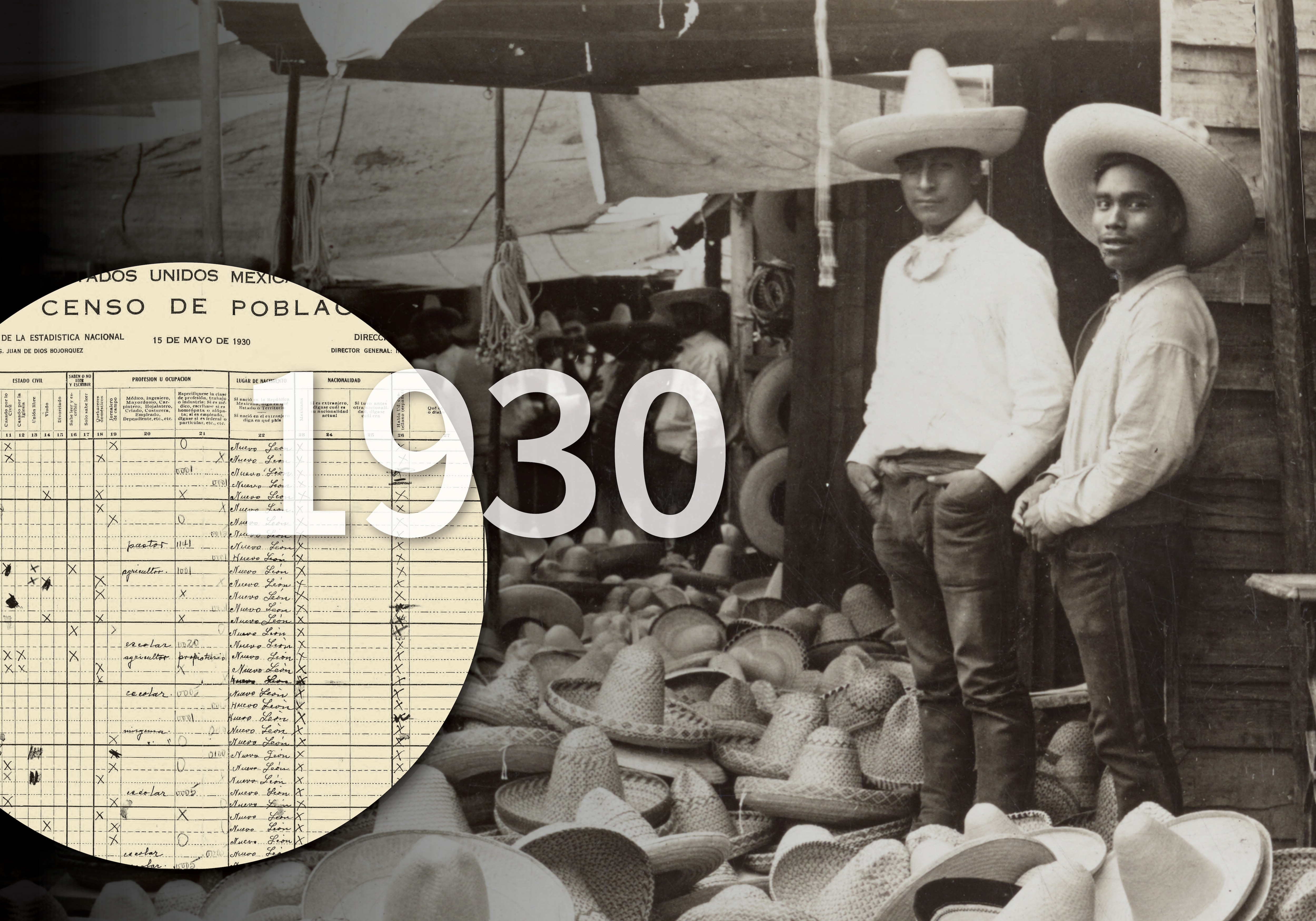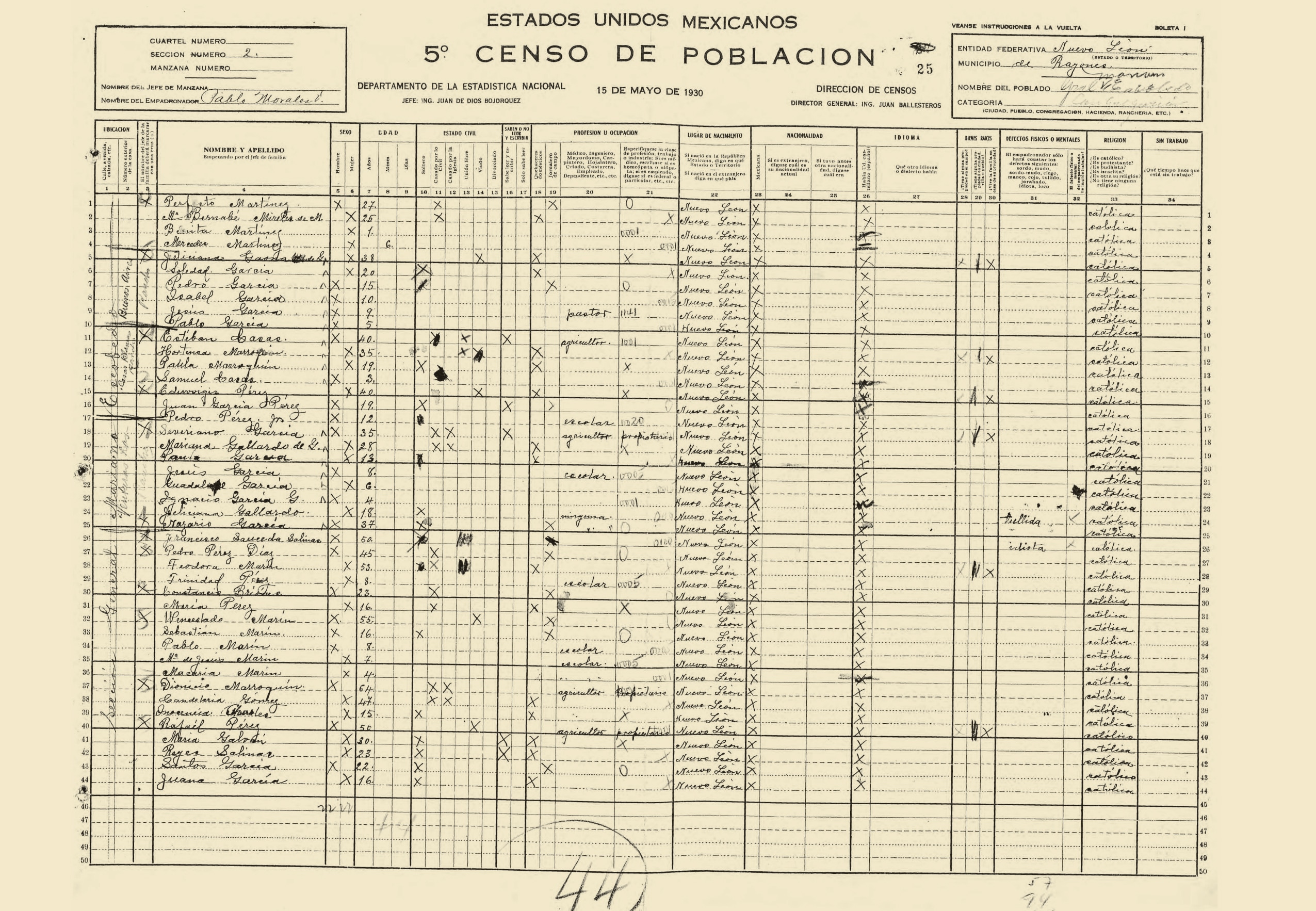Ancestry® Family History
The 1930 Mexico National Census
When the 1930 Mexico National Census took place, Mexico was emerging from the shadows of its recent revolution. President-elect Álvaro Obregón had just been assassinated, and the Cristero War was still a fresh wound in the memories of Mexican people. Yet these violent events would pave the way towards an era of peace, as 1930 marked the beginning of a 40-year period of steady social and economic improvement in Mexico.
If your family was in Mexico at the time, chances are they were enumerated in the 1930 census, just before a large migration of Mexicans towards the U.S. was about to take place.

What the 1930 Mexico Census Revealed About Mexico's Population
The 1930 Mexico Census is particularly important because it was the first census carried out under strict parameters and methods regarding design, planning, execution, and ultimate results, according to the Instituto Nacional de Estadística y Geografía, Mexico's Census Bureau.
With innovations in the organization, execution, and publication of census results, which established basic principles for subsequent censuses, it was a notable advance in the country’s census history.
The 1930 census collected fascinating data about the population, including each individual’s address and residency; whether head of household; name; gender; age; marital status and if married, whether married in a civil ceremony or by the church; literacy; occupation; birthplace; language spoken; physical and mental health; real estate; religion; and whether unemployed.
In fact, the ruling political party used the real estate question to promote a sense of pride among the people.
The census shows that Mexico's population was mainly rural. Yet the urban population had grown significantly. In 1920, 2.1 million people were living in cities, and by 1930 another 800,000 people in 45 cities had joined the ranks of city dwellers.
The population of Mexico City, the country’s capital, reached 1 million people, becoming by far the largest city in the country. In fact, it was larger than the next 13 cities combined.
However, cities in the northern area of Mexico such as Ciudad Juárez, Tampico, and Monterrey were also experiencing fast growth. And the 1930 Mexico National Census reflected the growth of border cities as well. Beginning in 1929 and throughout the 1930s, the United States began deporting Mexican nationals and by 1935, more than 500,000 Mexicans had been forcibly relocated to northern Mexico.
In 1930, more than half of the population was concentrated within only 8 states in central Mexico: Veracruz, Jalisco, Distrito Federal, Puebla, Oaxaca, Michoacán, Mexico and Guanajuato. This distribution of the population is one that has practically remained unchanged since then.
Mexican census data shows that Mexico's population was made up of 51% women and 49% men. It also shows that the most common female name was Maria, and the most common male name was Juan. The most common surnames were Hernández, García, and Martínez.

What the 1930 Mexico Census Can Reveal About Your Ancestors
The 1930 census included a vast number of details that can give you insight into your ancestors’ lives, from where they were born to their occupation to their physical health. It can also help you learn more about their pasts.
For instance, did your ancestors have Indigenous origins? The 1930 Mexico Census recorded the Indigenous population, not by ethnicity but by their native tongue. According to the records, roughly 16% of Mexicans spoke their native language, with Nahuatl, the ancestral language of central Mexico, being the most common. This was followed by Otomí and Maya.
Could your Mexican ancestors read and write? The 1930 Mexico Census recorded the literacy status of individuals. By the end of the Mexican Revolution, the government established an ambitious literacy plan to educate the population. By 1930 progress was steady but still modest—only 1 kid out of 3 was going to school.
Tips for Searching 1930 Mexico Census Records on Ancestry
The 1930 census records were the first to be compiled by official staff rather than by the citizens themselves, making it a more reliable source. Around 78% of the population was interviewed on May 15, 1930. Here are some pointers to keep in mind while you search your family's stories:
The census is a good place to start, but you'll need to dig a little bit deeper into other records. For instance, look for birth and death certificates if you want to uncover more family stories. Keep in mind that the census didn't ask for a birth date, just their ages around May 15th.
Be aware of the Mexican dual surname system. Usually, the last two elements of a name in Mexican records constitute the whole surname—with the father's surname first, then the maternal surname. But for people of Mexican origins migrating to the U.S. a common practice has been to keep the paternal surname and make the mother's surname into a middle name. To make things more interesting, this is not always the case. So, your ancestor born in Mexico might appear as Maria Dolores García Fuentes in Mexican records. But in U.S. records they might appear as Maria Fuentes García.
The official census staff filled in data with a pen, so it can be tricky deciphering their handwriting. Transcription errors are also possible. For instance, someone might have been named Teodosia, and their name might have mistakenly been written down as "Teodosa" and later digitized as "Teodora." Tweak your search a bit if you don't find your family names with the correct spelling right away.
Many of your Mexican ancestors were probably Catholics, so if they were born on the feast day of a saint they were often named after them. This means certain names tend to be common. It’s likely you might find people with the same name—and perhaps even the same surname—in the same area. If this is the case, be sure to double-check by using other data such as maternal surname or age.
Look for Your Family in the 1930 Mexico Census. As an historical milestone with over 12.8 million names, searching the 1930 Mexican census is a must when you want to get to know a little bit more about your Mexican family. Explore your family's stories with the help of the 1930 Mexico National Census on Ancestry®.
References
1930 Mexico National Census. Ancestry. (https://www.ancestry.mx/search/collections/1771/ : accessed 29 September 2021). About. Bracero History Archive. (http://braceroarchive.org/about : accessed 29 September 2021).
Garza, Gustavo. Evolución De Las Ciudades Mexicanas En El Siglo XX, 2002. (https://periodicooficial.jalisco.gob.mx/sites/periodicooficial.jalisco.gob.mx/files/evolucion_de_las_ciudades_mexicanas_-_gustavo_garza.pdf).
Goyes Vallejos, Johana. “Two Surnames, No Hyphen: Claiming My Identity as a Latin American Scientist.” Science, 13 May 2021. (https://www.science.org/careers/2021/05/two-surnames-no-hyphen-claiming-my-identity-latin-american-scientist).
Instituto Nacional de Estadística y Geografía (INEGI). “Quinto Censo de Población 1930.” Instituto Nacional de Estadística y Geografía. INEGI, 15 May 1930. (https://www.inegi.org.mx/programas/ccpv/1930/).
Martinez, Michael. “Mexico's 1930 Census Revealed, a Mine of Data for 32 Million Americans.” CNN, 25 September 2011. (https://edition.cnn.com/2011/09/24/us/1930-mexican-census/index.html).
Negrete, Martaelena. Relaciones Entre La Iglesia y El Estado En México: 1930-1940. 1st ed. El Colegio de Mexico, 1988. (https://doi.org/10.2307/j.ctv26d963).
Piccato, Pablo. The Assassination of Alvaro Obregón: Jury Trials & the Problem of Truth in Post Revolutionary Mexico. Centre for Research in the Arts, Social Sciences and Humanities (CRASSH). (http://www.crassh.cam.ac.uk/events/26428 : accessed 3 December 2015).
Población. Instituto Nacional de Estadística y Geografía (INEGI). (https://www.inegi.org.mx/temas/estructura/ : accessed 29 September 2021).
Sánchez, Francisco José Zamudio, Roxana Ivette Arana Ovalle, Waldenia Cosmes Martínez, Javier Santibáñez Cortés y Margoth Laredo Rojas. Análisis de los microdatos del censo de 1930: a 80 años del México posrevolucionario, Vol. 6, Núm. 3. Análisis Datos y Espacio Revista Internacional de Estadística y Geográfica. (https://rde.inegi.org.mx/index.php/2015/09/08/analisis-de-los-microdatos-del-censo-de-1930-a-80-anos-del-mexico-posrevolucionario/ : accessed 28 September 2021).
U.S. Library of Congress. Mexico: Institutional Revolutionary Party (PRI). Country Studies. (http://countrystudies.us/mexico/84.htm : accessed 29 September 2021).